
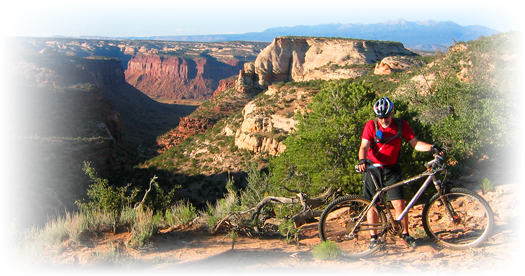 29er Testing in Moab
29er Testing in Moab
DREAMRIDE WR TI 29ERS SOLD OUT!
DREAMRIDE FULL SUSPENSION | MOOTS MOOTO-X
NEW! IF SIX WAS NINE: 26 TO 29 CONVERSION KIT
MORE TESTING RESULTS: THE BIG WHEEL RANT
1) Momentum is the key to understanding advantages of the larger wheels. Whatever dissipates momentum is the enemy of the 29 inch wheel (especially with fat tires). Whatever creates momentum is friend to 29ers. A 29er will eat up a 26 inch wheel bike on flat or lightly rolling terrain. On a long steady or slow technical climb, the 26 inch wheel has the advantage, but this advantage can be overcome by a 29er pilot on a very light 9er with a relentless clock-steady cadence. He who gains momentum anywhere will succeed in maintaining separation with a 26er. It will take more energy to get a fatter-tired 29er up the hill because a 26 inch wheel overcomes static inertia far better than the 29er due to the lower rolling mass, making acceleration far quicker and sustained climbing less draining. That said, a 29er tire's contact patch is a huge advantage when climbing in loose conditions on any trail (see #4). Narrower cross tires on a 29er will sometimes cancel out the 26er's advantage when it comes to climbing tight and technical terrain.
2) Stability at speed, generated by the rotational weight of larger wheels and fat tires, is a downhill advantage for a good 29er. Small bumps on road surfaces are not nearly as serious with the larger contact patch, so speed can be maintained with less effort. Wheels that roll over small bumps without a blip also stick to the surface in turns. A similarly equipt and piloted 26er is going to have a very difficult time keeping up with a 29er going down a dirt road. The 9er is suits any situation where speed is generated and can be maintained, EXCEPT WHEN THE G FORCES BUILD AS TURNS GET TIGHTER. Over rougher terrain or when tight turns are encountered at speed, a 26 inch wheeled bike has a SUBSTANTIAL advantage: Lateral rigidity, the Holy Grail of bike handling. The bigger wheels start to flex as the forces mount. It's easy to see for yourself. Just go fast--35 miles an hour or so, if you dare, over a hardpack to somewhat loose uneven dirt road surface. Go all out on a straight section and weave across ripples and ruts. Find a long rut and cross it. You will feel the longer spoke length as a strange low frequency wobble, amplified and distorted by gyroscopic forces of the larger tires. It is certainly something you can manage with commons sense. For accuracy and strength, go 26. For smooth straight line ripping on long stretches of dirt road, a 29er is smooth, smooth, smooth and smooth. But REMEMBER: You can actually ride your hubs through the rims and spokes on a 29er wheelset, so don't even think about drifting into a turn that isn't buttery smooth, unless your spokes are tight. Maybe with a new generation of spokes and rims, a breed of heavy 29er downhill racers will emerge, but for now, I cannot emphasize enough: Don't go downhill race speeds off-road on any currently available pre-built wheelset. The fatter the tires, the more stability you are going to notice, but fat tires on a 29er cause serious wind resistance. Anyone who learns the avantages of larger wheels is going to end up prefering a lighter narrower tire with very shallow knobs. A 29er running a 2.1 tire feels about as stable as a 26er running a 2.3 or 2.4 at speed. Run a 2.3 on a 29er and the difference is substantial, but it will feel sluggish, and low frequency shiver is amplified. The best tire for a rigid 29er is usually a meaty cyclocross version with a dimpled belly and/or low tread. Mountain bike tires over 2.1 are for sand and beach cruising, or to soften big rocks on a rigid bike. A fatter, grippier tire up front works great and slackens angles (many 9ers are overly steep) for sharp rock edges, loose rock and sand. Looks cool, too.
3) Due to the increased flotation afforded by the long, wide contact patch of a 29 inch wheel, negotiating sand and loose gravel is far more efficient. This is noticed instantly on Moab terrain. Because of the huge footprint of the 29 inch wheel, a narrower tire will suffice to get you across deep sand, but a really fat tire gives you superhuman powers, allowing a good rider to start and stop in really deep sand. The trade off is not acceptable due to the loss of slow speed stability of the much higher bottom bracket caused by really, really fat tires, unless you are riding miles of beach sand and pedaling over turtles. Hitting a patch of sand at speed only requires a weight shift aft on a 9er. A 29er with a relatively narrow tire will allow you to stand and climb on gravel. Try that on a 26er.
4) Rim brakes work better on a 29er than a 26er. Those brake surfaces are huge, and, as a direct result, heat dissipation is far better. Modulation is improved, too, due to the larger "disc" the rim of a 29er provides. If you are looking to save weight and retain simplicity for travel, this is very good news. For the ultimate in 29er stopping power, try a set of Magura hydraulic rim brakes.
5) Tight handling becomes a tad awkward with larger wheels and really fat tires, but this is generally caused by that "moment of inertia." Expert bike handlers will appreciate skinnier, lighter tires. 2.0 tires are perfect for all around mountain biking. With any tire size, however, the larger wheels roll over roots and rocks. Disadvantages of fatter tires vanish when you maintain a cadence over bumbs and during low speed turns. A high bottom bracket is appreciated on a 29er because pedaling should be maintained as much as possible. Of course, full suspension 26ers trump the 29er in tight technical rocks and roots that require bursts of effort and acceleration. A fat-tired 29er feels like you are between the wheels of the bike. A 26er feels more like you are over the wheels, giving you a confident feeling of control while going slow over big rocks or roots. Narrow tires on a 29er move the wheels more underneath your body and offer the best of both worlds.
6) Sizing: The 29er format is only a benefit to those who fit its performance window. Riders from 5'7" to 6'2" tall are prime candidates, but riders over 215 pounds or very aggressive riders over 200 pounds should stick with the more rigid and stronger 26 inch wheel for a mountain bike (especially on the rear). Longer legs and added weight of riders over 6'3" will torque the wheels causing unwanted lateral flex. Gentle tourers with weights up to 235 pounds can use a 29er on the road and find that it is far more comfortable, safe and stable than a road bike. Actually, if you are over 225, a road bike may not be in the cards for you, but a 29er with narrow tires is a fantastic alternative. For shorter riders there is a good possibility that any frame under 16" will have considerable toe-tire overlap, especially with fatter tires, so expect to run cyclocross tires to get enough clearance for slow speed maneuverablity.
7) More on sizing and parts for big guys: Big aggressive boys should stop thinking about this wheel size for a mountain bike. Yes, it is sad, but the initial marketing of the 29er to riders over 6'2" and 225 pounds was a huge mistake. And yes, the wheels are bigger, but no one makes 12 guage spokes or rims that accept them. An alternative for larger riders could be using 40 spoked wheels, but more spokes mean less lateral rigidity. Handling will suffer and you can ride your hubs through the spokes in hard turn. Somebody should step up to the plate with a good rim and maybe then we can expand the weight and height range of the 29er. If we had Keith Bontrager on our side nowadays, I am sure he would cob up something in his garage, but alas, he is too busy with the road weenies right now and too wealthy to remember what hippies need. Keith's garage is now a huge factory with offices full of engineers and marketing fruits. Ahhh, when you get money, you become a Republican. Republicans really have no business on a bicycle (unless they really understand the meaning of "conservative"), even if they can win the Tour seven times. And Democrats should stay away from bicycles altogether. They are just too whimpy and shakey to ride a bike with intent and confidence, and the 29er needs both. A bicycle is for communists, real Leninists, Moaists. A 29er is the perfect "red" machine. Think about it. Power to the people! Aw, come on. Lighten up, but Big Boys shouldn't lighten up their 29ers too much are they will find out how to eat a very large Mexican Revolution taco in one bite.
8) 29er wheelsets need wider axles and hub flange distances. Get on that one, somebody.
9er) Rear suspension is not a very good idea on a 29er. Wheels that are already as heavy as they can be for strength, need to be even heavier to handle the side loads of speed that suspension allows. No one makes a good rim for this purpose, except Mavic and the rim I am speaking of is a road rim. Let me say that again, "NO ONE MAKES A 29ER RIM FOR FULL SUSPENSION BIKES!" What we truly need is a really fat rim with reinforced eyelets (a Mavic EX719-9er!). The 29 inch wheels already eat up bumps, so, in the end, the added weight, flexibility and complexity of rear suspension may be missplaced and misunderstood on a 29er. A smaller wheel on a suspension bike is actually more desirable (especially in the rear). If you want to ride the really gnarly rocks, or if you are a larger rider, or if you simply want plush comfort and safety afforded by the maximum erasure of trail obstacles that a full suspension bike can provide, get a DREAMRIDE FULLY with 26 inch wheels or a 26-29 combo. For really big guys, wire yourself for performance with the DREAMRIDE MUTANT. There is a limit to the performance abilities of the 29 inch wheel. Thank God we have choices!
10) Why most 9ers are just for east coast fire roads: In Moab we have slickrock hills that can be ridden WITH A HIGH BOTTOM BRACKET, huge baby dinosaur heads that can be ridden WITH A HIGH BOTTOM BRACKET, and specific obstacles like that one rock on the Portal Trail should not be ridden over UNLESS YOU ARE CRAZY, NOT PEDALING, AND/OR HAVE A HIGH BOTTOM BRACKET. I have noticed that just about every hardtail mountain bike offered at this point in time has a bottom bracket so low as to make the bike useless for pedaling through technical terrain, let alone sidehilling slickrock domes. There were rigid bikes built in the late 80's and early 90's that were specifically designed for rough terrain. These bikes had very high bottom bracket heights. The Nishiki Alien was very popular in Moab due to its height. The early Manitou bikes were designed for pedaling over the rough rocks and big roots of Colorado's Front Range. We carried those Manitou bikes for many reasons, one of which was the high bottom bracket. We still have one of these early Manitou HT bikes in the shop. We keep it here because it works for Moab terrain. People like their bikes to feel low for that "home to mom" safety feeling. A low bb works great while you are coasting over the bumps at speed. But, if you want to put power down, you have to be very careful or you will use up a lot of energy trying not to whack a pedal. Whacking a pedal is the most energy-robbing and (sometimes) DANGEROUS thing that can happen on a hardtail. Yes, you might like that low bb because you can put a foot down without getting off the saddle and it keeps your fat ass from toppling over at a standstill, but when I leave these guys behind on bumpy terrain on a FULLY RIGID WR 9er and appear unphased after a really nasty section of embedded bowling balls, they realize the value of that high bb. Motto: If you are riding the road, low bb is good. If you are riding technical trails, bb must be high. Even a half inch of extra bb height should be an attractive feature of any 9er that is to be truly used as a mountain bike.
29 Inch Wheel
Handling and Performance Benefits and Quirks
Copyright Dreamride LLC. No material, written, graphics, or photographs on this website, may be reproduced, broadcast, published, re-written, re-edited, or re-used in any way outside of this site without written consent of Dreamride LLC and Lee Bridgers. Use of this site signifies agreement to terms of use.
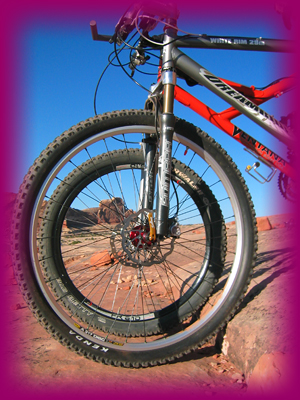 26 inch ~ 29 inch
26 inch ~ 29 inchHere is a picture of a 26 inch wheel with a 2.5 tire and a 29 inch wheel with a 2.1 tire. Notice the difference in the size of the triangular patch of light under the tires at the rut. Notice each contact patch in relation to the ledge. Duh.
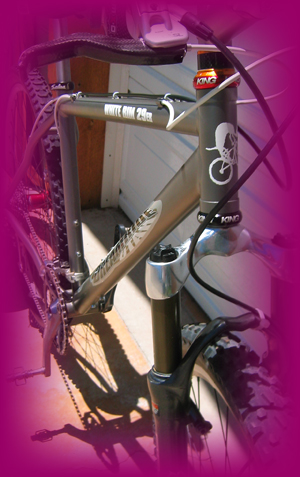
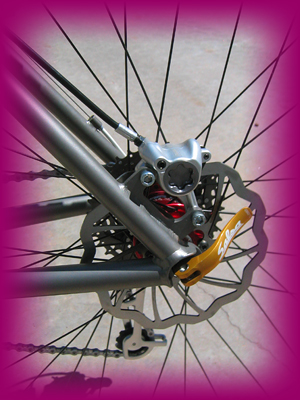
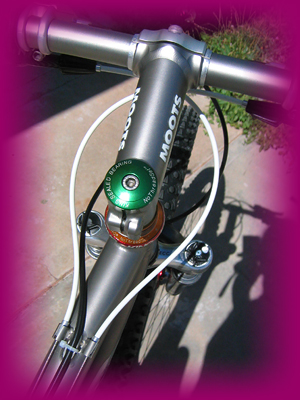
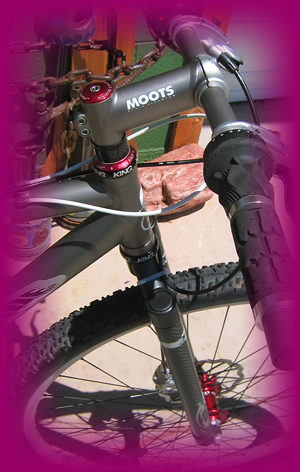
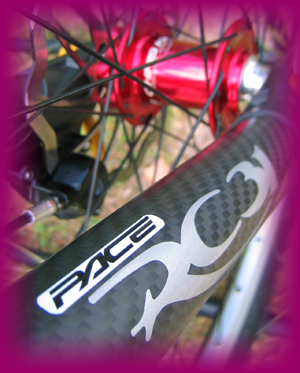
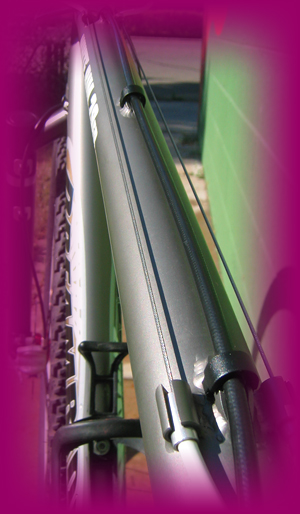
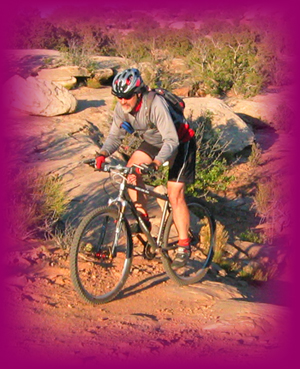
Pictures above are of the Dreamride White Rim 29er, our titanium frame with a MAX parts kit. This bike is available, built for us by Lynskey. You can also get it with a 26" rear wheel, custom paint, rim brakes, matching steel fork and a high end parts kit that includes Moots, Chris King and XTR components.
